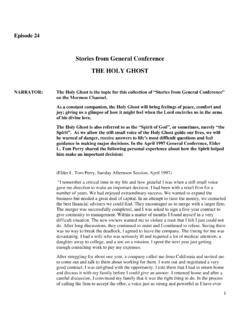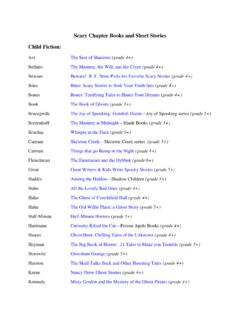Transcription of The Significance of Ghosts - Lund University
1 The Significance of Ghosts - Science, Religion and Social Criticism in Charles Dickens The Haunted Man and the ghost s Bargain, A Christmas Carol and The Signalman Niki Brodin Larsson ENGK01 Degree essay in English Literature Autumn semester 2013 Centre for Languages and Literature Lund University Supervisor: Ellen Turner Table of Contents Introduction 1 Historical Context 2 The Scientific Explanation 6 Christian Beliefs 9 Social Criticism 14 Conclusion 18 Works Cited 20 Niki Brodin Larsson 1 Introduction The Haunted Man and the ghost s Bargain (1848), A Christmas Carol (1843) and The Signal-Man (1866) are all works by Charles Dickens that tell stories about haunted men. Dickens employed spectres in many of his texts from the 1840s until the 1860s, and his contribution to the development of the ghost story in the Victorian era was very prominent.
2 It was his stories that strengthened the association between ghost stories and Christmas for the middle-class (Henson 44; Briggs 40). Dickens was an important voice in the controversy regarding the nature of Ghosts . In his weekly literary magazines Household Words (HW) and All the Year Round (ATYR) he published many popular ghost stories , but, as a journalist, he also questioned and examined many supernatural phenomena (Henson 44). He was very critical of superstitious belief, and often debated the reliability and authenticity of different spiritual manifestations (Henson 44). Louise Henson concludes that Dickens s position in the ghost controversy can .. be identified as a naturalistic one, although the explanations he endorsed relied on occult as well as known physical forces (61).
3 The Haunted Man and the ghost s Bargain, A Christmas Carol and The Signal-Man are all ghost stories from the mid-nineteenth century, a category of literature which definition many scholars disagree about. ghost stories from the Victorian era have traditionally been associated with female writers such as Elizabeth Barrett Browning, Charlotte Riddell, Amelia Edwards, or Violet Paget (Auerbach 280). However, this is something that Nina Auerbach strongly opposes in her article Ghosts on Ghosts where she states that, even if you do not take Dickens Christmas ghost stories into consideration, there is no reason to argue that the ghost story specifically belonged to female authors in the nineteenth century (280). Victorian ghost stories have also been seen as horror tales belonging to the Gothic genre (Auerbach 280; Sanna 85).
4 However, Srdjan Smajoc contradicts this notion in his article and states that Ghosts seem to belong in almost every genre of literature, and therefore, consequently, nowhere (1107). This essay agrees with Auerbach and Smajoc, and will, rather than formulating any claims about the genre of Victorian ghost stories , examine what these stories can tell us about certain aspects of the time they were written. The Victorian era was a period of constant change; industrialization and the rise of science made people doubt their religious beliefs. Consequently, many religious Niki Brodin Larsson 2 and cultural aspects that were previously considered truths were suddenly questioned. What many have considered strange is that in these times of uncertainty there was a sudden rise in the interest in the supernatural (Gavin 19).
5 Adrienne E. Gavin s explanation for the popularity of the ghost story is that it was a reassurance for the Victorian reader that not everything was changing (20). The ghost story reassured in two ways, firstly by re-entrenching social and moral conventions , and secondly, by affirming certain Christian beliefs, such as the existence of an afterlife or that sinners will be punished after death (Gavin 20, 23). Lots of people have speculated about the sudden popularity of the ghost story and Spiritualism in the nineteenth century, but many agree with the explanation that Gavin advocates, that it in many ways reassured the Victorian reader and confirmed many Christian beliefs. The aim of this essay is to examine in what way Dickens uses Ghosts in The Haunted Man and the ghost s Bargain, A Christmas Carol and The Signal-Man , and what this can tell us about what scientific explanations people had for the manifestation of Ghosts .
6 This essay will also argue, in agreement with Gavin (20), that these works reassured the Victorian reader by confirming certain social and moral conventions as well as certain Christian beliefs. The Haunted Man and the ghost s Bargain and A Christmas Carol confirm in different ways that there is an afterlife, that sinners will be punished after death and that Christmas time is sacred. There is also a prominent theme of repentance in both of these stories . The stories discussed in this essay furthermore seem to criticize the changes in Victorian society. The story of the signalman mirrors the common fear of rapid industrialization and draws attention to the dangers of technological advancements, while The Haunted Man and the ghost s Bargain and A Christmas Carol advocate greater awareness of the vulnerable and poor people in society.
7 This essay will try to explain how these ghost stories by Charles Dickens managed to appeal to both the Christian and the more scientifically oriented reader, and at the same time raise social awareness. Historical Context The nineteenth century was a turbulent time where industrialism and science coexisted with supernatural beliefs and Christianity, and where hopes for the future collided with tradition and sentimental feelings about the past. For the Victorians, the nineteenth Niki Brodin Larsson 3 century was filled with unexplainable phenomena; the supernatural seemed to inhabit both the cultural as well as the physical world. What came of the technical progress of the nineteenth century, such as telephones and railways, seemed to surpass the laws of science and often frightened people as much as it fascinated them (Bown, Burdett and Thurschwell 1; McLeod 7-8).
8 According to Bown, Burdett and Thurschwell the collapsing of time and distance achieved by modern technologies that were transforming daily life was often felt to be uncanny (1). For most people electricity was just as baffling as communication with the dead, and the world just seemed to be inhabited by a multitude of inexplicable invisible forces (Bown, Burdett and Thurschwell 1). Furthermore, the lives of most Victorians, but especially the workers, were being vastly altered as a result of industrialization (Finucane 175). Small-scale rural life was replaced by overcrowded cities, and the demand of huge numbers of workers gave rise to unsanitary, vermin infested ghettos with poor food and water supplies where diseases spread quickly (Finucane 175; Moran 40-1). A certain sense of uncertainty seemed to prevail in the ever-changing nineteenth century.
9 The fluctuations in the economy made people uncertain about their future while the theories of Darwin made them doubt their religious beliefs. It was in this time of uncertainty, where the interest and popularity of ghost stories and spiritualism reached new heights (Noakes 23; Gavin 19). There seemed to be a lack of consensus about the nature of in the nineteenth century. Some people believed that Ghosts had nothing to do with the natural world, that they were by definition supernatural, while others argued that these manifestations easily could be explained within the laws of science (Noakes 23). According to Noakes (28), different texts from the time upheld both natural and supernatural explanations including evil spirits, angels, conscious acts of trickery, unconscious psychological and physiological mechanisms or hitherto unknown forces associated with the human body.
10 Many researchers tried to find scientific proof for Ghosts and other supernatural phenomena, and a Society for Psychical Research was even established to determine the exact nature of them (Briggs 52; Bown, Burdett and Thurschwell 1). The prevailing explanations for why certain people were seeing Ghosts were to be found in the human psyche. Spectral manifestations were seen as symptoms of some form of mental disturbance, but the science of psychology was not very developed in the nineteenth Niki Brodin Larsson 4 century. Psychology was just being recognized as a serious field of study and was still regarded with great suspicion by many (Briggs 55, 143). Many, including Dickens, believed that the visions that people experienced had their origins in the unconscious part of our mind.










